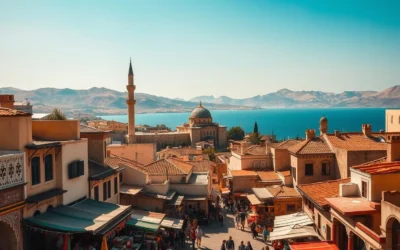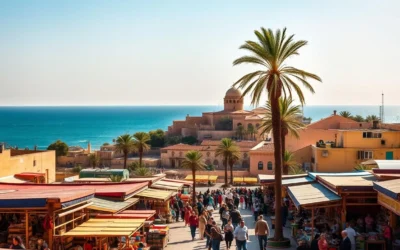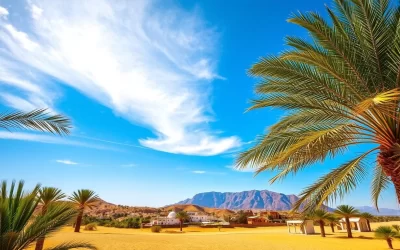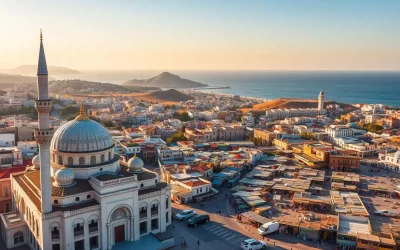✓ Tours & Activities✓ Tours & Activities ✓ Tours & Activities
When you explore the linguistic landscape of this North African country, you’ll find a rich blend of tradition and modernity. Arabic is the official language, deeply rooted in the constitution and taught in schools from an early age. This reflects its importance in shaping the nation’s identity.
In everyday life, Tunisian Arabic, also known as Darija, is the primary dialect spoken by the population. It’s a unique variation that connects people across the country. Alongside this, French holds significant influence, especially in education, business, and media, due to historical ties.
This blend of languages highlights the cultural diversity of the region. From Standard Arabic in formal settings to the vibrant dialects of daily life, each plays a role in defining the community. Stay tuned as we dive deeper into this fascinating topic in the next sections.
Introduction to Tunisia’s Linguistic Landscape
The linguistic tapestry of this North African nation reveals a fascinating mix of history and culture. From ancient migrations to modern-day influences, the language scene here is a testament to its rich heritage.
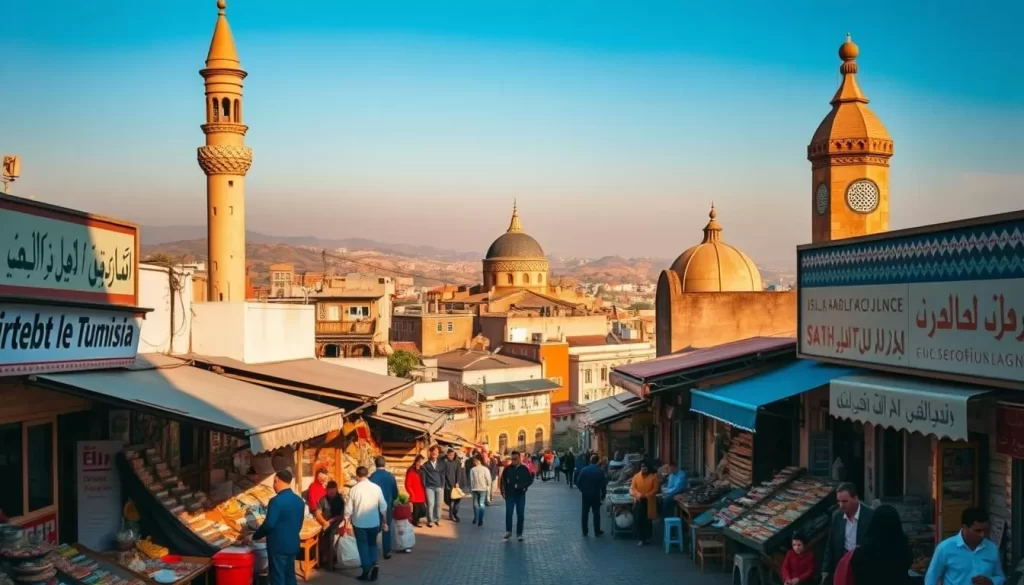
Understanding the Cultural Diversity
This country’s multicultural background has shaped its linguistic environment. Arab, Berber, Turkish, Greek, Roman, and French influences have all left their mark. These diverse roots create a unique blend of formal and colloquial language variations.
In everyday life, Tunisian Arabic dominates as the primary dialect. It’s a vibrant reflection of the region’s identity. Literary Arabic, on the other hand, is reserved for formal settings, showcasing the duality of language use.
How History Shaped the Language Scene
Historical migrations and cultural exchanges have enriched the language pool. For example, Turkish loanwords number between 200 and 500, while Spanish words entered through Morisco migrations. These elements highlight the dynamic evolution of speech patterns.
Regional differences also play a role. From the north to the south, dialects vary, adding another level of complexity. This diversity ensures that every person’s experience with language is unique.
| Influence | Impact on Language |
|---|---|
| Arab | Introduced Literary Arabic and local dialects |
| French | Influenced education, business, and media |
| Turkish | Added loanwords to the vocabulary |
| Spanish | Contributed words through migration |
Historical Evolution of Tunisia’s Languages
The evolution of language in this region reflects centuries of cultural exchange. From ancient migrations to modern influences, the linguistic identity has been shaped by a series of historical events. This transformation has left a lasting impact on the population and the way they communicate today.
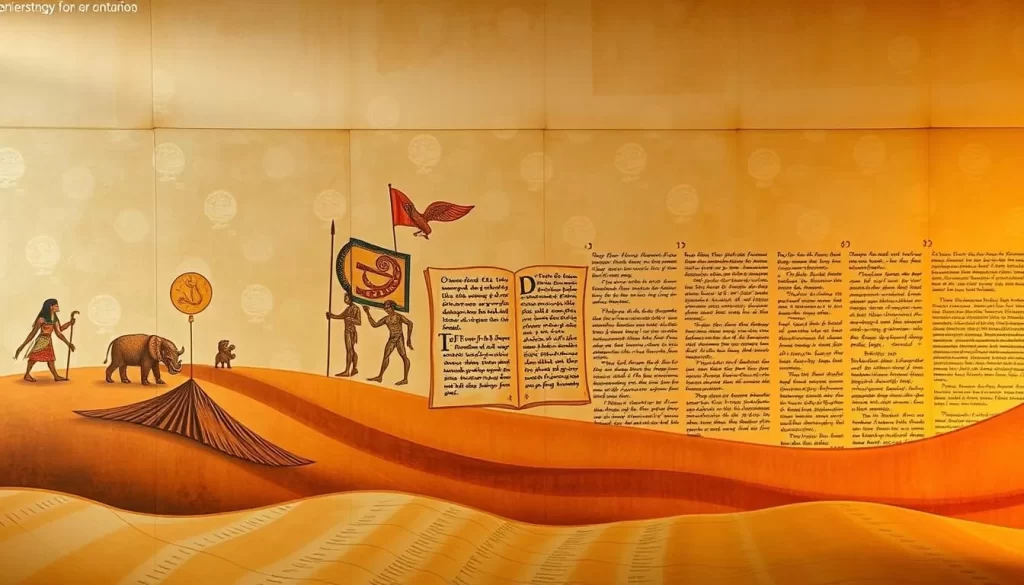
The Arabization Process and Its Impact
Arabization began in the 7th century and was mostly complete by the 12th century. This process established Modern Standard Arabic as the cornerstone of official discourse. It became the primary language for education, governance, and literature, deeply influencing the community.
Today, Arabic remains the only official language, as stated in the Constitution. This historical shift has ensured its dominance in formal settings, while local dialects continue to thrive in everyday life.
Influence of French and Other European Languages
French gained prominence during the protectorate era and remains significant post-independence. It is widely used in education, business, and media, serving as a key social marker. Other European languages, like Italian, also played a role, especially in trade and migration.
These influences have created a unique linguistic blend. While Arabic is the official language, French and other European tongues continue to shape modern communication. This duality reflects the country’s rich history and cultural diversity.
Exploring Tunisia: Official and widely spoken languages
The way people communicate in this region reflects a deep connection between tradition and modern life. Two forms of Arabic coexist, each playing a distinct role in shaping the country’s identity. This balance between formality and everyday speech is a key part of the cultural fabric.
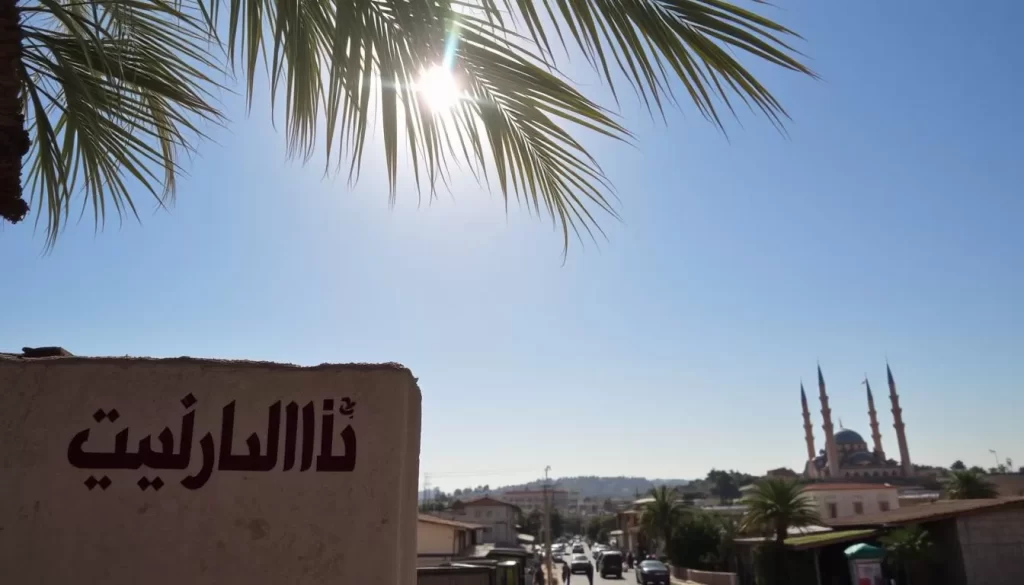
The Role of Literary Arabic
Literary Arabic, also known as Modern Standard Arabic, is the formal language used in government, education, and media. It’s taught in schools from an early age, ensuring its role in official communication. This form of Arabic connects the country to the broader Arab world, fostering unity and shared heritage.
In formal settings, such as legal documents or news broadcasts, Literary Arabic is the standard. Its use highlights the importance of tradition in public life. Families often encourage children to master it, seeing it as a gateway to opportunities.
Understanding Tunisian Arabic
In contrast, Tunisian Arabic is the everyday dialect spoken by the majority. It’s a vibrant mix of Arabic, Berber, and French influences, reflecting the region’s history. This dialect is the heart of daily conversations, making it essential for social interactions.
From markets to homes, Tunisian Arabic brings people together. Its informal nature makes it accessible, while its unique vocabulary adds a local flavor. Families often pass it down through generations, preserving its role in community life.
Together, these two forms of Arabic create a dynamic language scene. They complement each other, blending tradition with modernity in a way that defines the region’s identity.
Minority and Foreign Languages in Tunisia
The linguistic diversity of this North African nation extends beyond its primary dialects, embracing a mix of minority and foreign influences. While Arabic dominates as the official language, other tongues add depth to the cultural fabric. These languages reflect the country’s history and its evolving connections with the world.
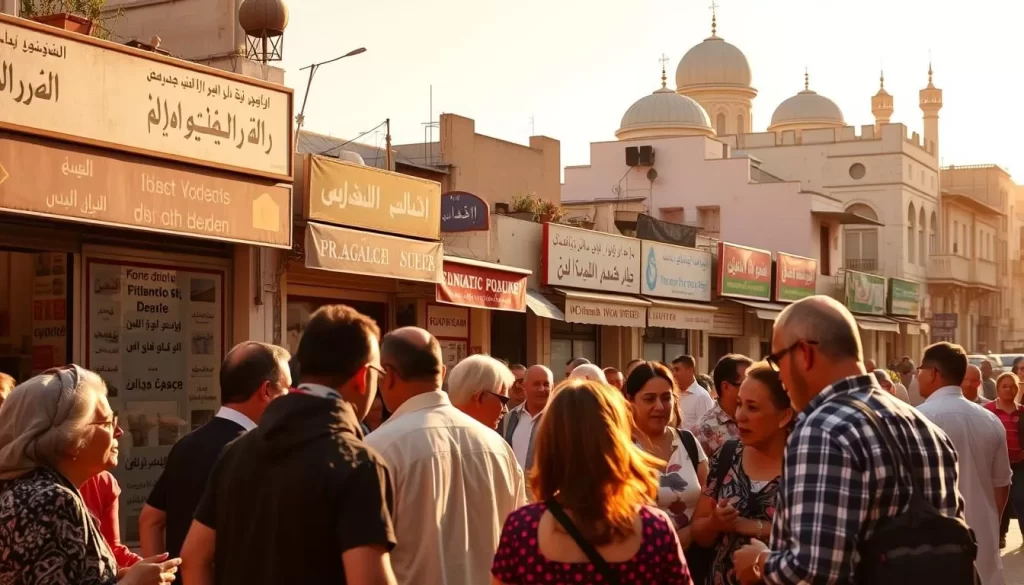
The Preservation of Berber Languages
Berber languages, also known as Tamazight, are spoken by a small percentage of the population, primarily in southern villages and on the island of Djerba. Efforts to preserve these languages have gained momentum, especially after the 2011 revolution. Today, there are 13 Amazigh associations dedicated to revitalizing Berber culture and language.
Despite these efforts, challenges remain. Many children in Berber-speaking regions face difficulties in school, where Arabic is the primary medium of instruction. Activists are working to raise awareness and mobilize support for the preservation of this ancient berber language.
Rise of French, English, Italian, and Turkish
French continues to hold significant influence, especially in education, business, and media. Approximately 63.6% of the population speaks French, primarily as a second language. Its role as a prestige language ensures its relevance in intellectual and professional spheres.
Other foreign languages, like English, Italian, and Turkish, are also gaining traction. English is increasingly popular among younger generations, while Italian and Turkish are tied to historical migration and trade. These languages contribute to the dynamic language scene, blending traditional roots with global influences.
- French remains a key language in education and commerce.
- English is growing in popularity, especially among the youth.
- Italian and Turkish reflect historical connections and migration patterns.
This mix of minority and foreign languages highlights the country’s adaptability and its ability to balance tradition with modernity. Each language adds a unique layer to the cultural identity of the region.
Language, Education, and Social Integration
Education plays a pivotal role in shaping the linguistic identity of this North African nation. The school system emphasizes Modern Standard Arabic, ensuring students master the formal language used in governance, media, and literature. This approach reflects the country’s commitment to preserving its cultural heritage while meeting modern needs.
The curriculum includes historical, grammatical, and practical components to ensure proficiency in Arabic. Students learn to navigate both formal and informal settings, bridging the gap between Literary Arabic and the everyday dialect. This dual focus fosters a deeper understanding of the language and its role in the community.
Arabic in the School System
From primary to secondary education, Arabic is the cornerstone of the curriculum. It’s taught alongside French, which remains a key language in business and higher education. This dual-teaching approach prepares students for both local and international communication demands.
Educational reforms have aimed to balance tradition with global standards. For example, the introduction of English as a second foreign language from the fifth grade reflects the country’s adaptability to global trends. These efforts ensure students are well-equipped for a multilingual world.
- Modern Standard Arabic is taught for formal communication.
- French is integrated to meet international demands.
- English is introduced early to enhance global competitiveness.
Language in education also fosters social integration. By promoting proficiency in Arabic and other languages, schools help bridge cultural divides. This approach strengthens the community and ensures equal opportunities for all students.
Linguistic Diversity and Community Life
Everyday conversations in this region reveal a vibrant mix of dialects and traditions. From bustling markets to quiet homes, language serves as a bridge connecting people across diverse backgrounds. This dynamic interplay shapes how individuals interact and build relationships.
Impact of Language on Everyday Interactions
Tunisian Arabic is the heartbeat of daily communication. It’s the dialect that brings people together, whether they’re haggling in a marketplace or sharing stories at a family gathering. This informal yet expressive language fosters a sense of belonging and strengthens community bonds.
Language differences also play a role in interpersonal relationships. In urban areas, French often acts as a social marker, while in rural regions, Berber language speakers maintain their unique identity. These variations highlight the rich cultural tapestry of the country.
- Tunisian Arabic dominates daily conversations, creating a shared sense of identity.
- French is often used in professional settings, bridging social gaps.
- Berber language speakers preserve their heritage, adding depth to the cultural landscape.
Language also serves as a tool for leveling social differences. In public events, you’ll hear a mix of dialects and tongues, reflecting the inclusivity of the community. This diversity ensures that every person feels valued, regardless of their background.
For more insights into how Arabic and other languages shape daily life, explore the linguistic landscape of this fascinating region.
Cultural Identity Through Language and Migration
The cultural identity of this region is deeply intertwined with its linguistic evolution, shaped by centuries of migration and exchange. From ancient settlers to modern-day movements, each wave of migration has left its mark on the language spoken today. This blend of influences reflects the country’s rich history and its ability to adapt to change.
How Migratory Influences Enriched the Language Mix
Migration has been a driving force in shaping the modern language mix. Greek, Roman, Turkish, and European settlers brought new vocabulary and linguistic styles, creating a unique blend of dialects. For example, Turkish loanwords number between 200 and 500, while Spanish words entered through Morisco migrations.
These influences are evident in regional variations. From the north to the south, dialects differ, reflecting the diverse origins of settlers. This diversity ensures that every family’s experience with language is unique, preserving a sense of identity amidst change.
Family traditions play a crucial role in maintaining linguistic heritage. Parents often pass down dialects and vocabulary, ensuring that cultural influences remain alive. This practice strengthens the bond between generations and keeps the region’s history alive in everyday conversations.
| Migration Influence | Impact on Language |
|---|---|
| Greek and Roman | Introduced ancient vocabulary and grammatical structures |
| Turkish | Added loanwords and cultural expressions |
| European | Influenced education, business, and media |
Today, the merging of cultural and linguistic influences is evident in daily life. From markets to homes, you’ll hear a mix of dialects and tongues, reflecting the inclusivity of the country. This diversity ensures that every person feels valued, regardless of their background.
Conclusion
The linguistic landscape of this region reflects a unique blend of tradition and modernity. Standard Arabic remains central to formal communication, while Tunisian Arabic thrives in daily life. This duality shapes the country’s identity, connecting its population to both heritage and contemporary culture.
Education plays a key role in promoting language proficiency. Schools emphasize Standard Arabic, ensuring students master formal communication. At the same time, French and English are integrated to meet global demands, preparing the younger generation for a multilingual world.
Minority and foreign influences add depth to the cultural fabric. Berber dialects and European languages enrich the language mix, reflecting the region’s adaptability. This diversity ensures every person feels valued, fostering social integration.
To explore more about this fascinating country, visit this resource. Discover how language defines not only communication but also community and cultural heritage.
The above is subject to change.
Check back often to TRAVEL.COM for the latest travel tips and deals.

